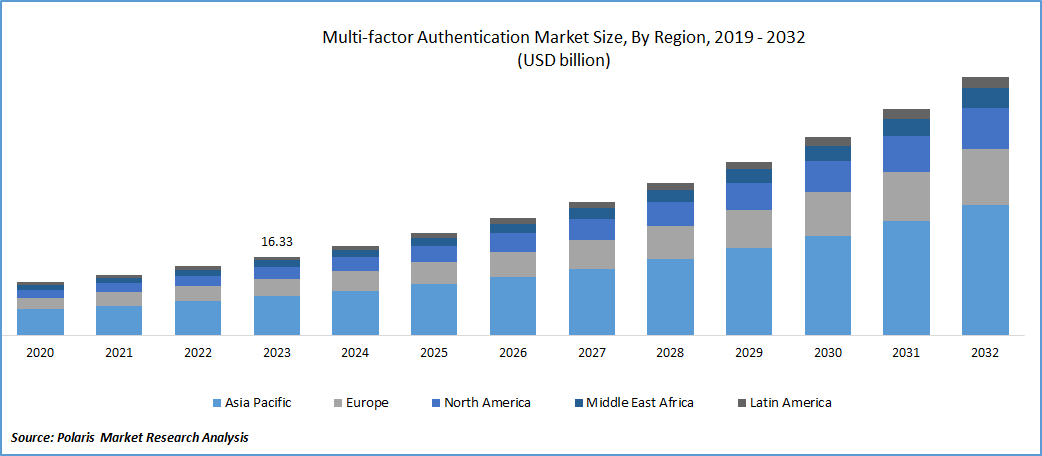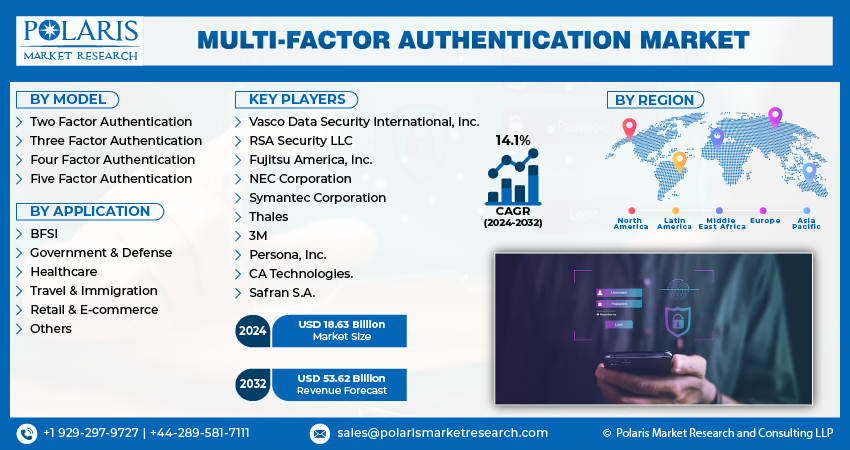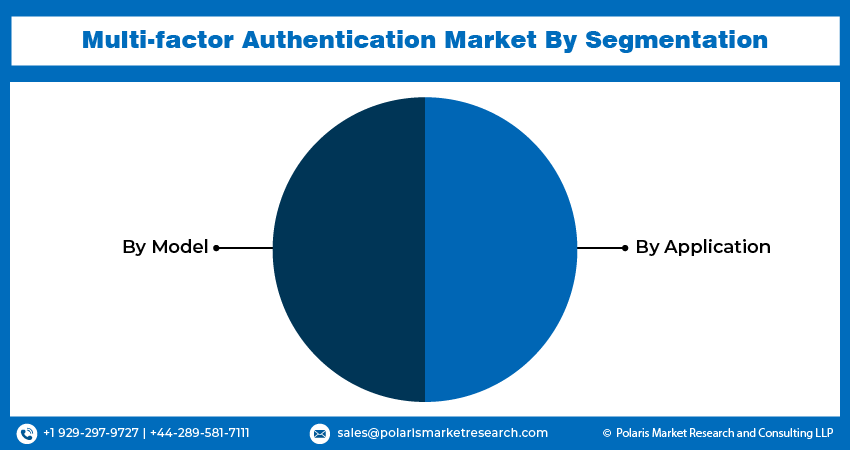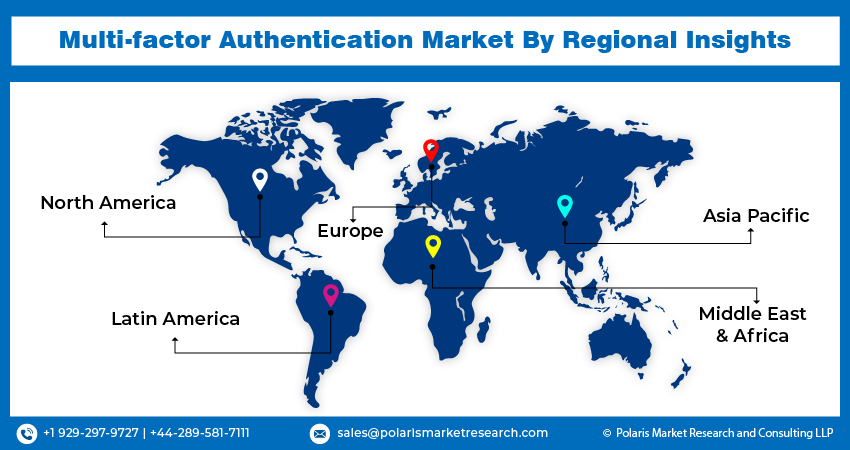
Multi-factor Authentication Market Share, Size, Trends, Industry Analysis Report, By Model, By Application (BFSI, Healthcare, Government and Defense, Travel and Immigration, Retail), By Region, And Segment Forecasts, 2024 - 2032
- Published Date:Feb-2024
- Pages: 120
- Format: pdf
- Report ID: PM4241
- Base Year: 2023
- Historical Data: 2020 – 2022
Report Outlook
The global multi-factor authentication market was valued at USD 16.33 billion in 2023 and is expected to grow at a CAGR of 14.1% during the forecast period.
Multi-factor authentication (MFA) enhances security by adding extra layers of authentication to verify user identities and safeguard online transactions. One of the significant trends contributing to market growth is the rise in cyberattacks and data breaches experienced by organizations. This alarming trend, coupled with stricter regulations aimed at protecting sensitive data, is expected to drive the growth of the market.

To Understand More About this Research, Request a Free Sample Report
As cyber threats become more sophisticated, organizations are recognizing the need for robust security measures beyond traditional passwords. MFA provides an additional barrier, requiring users to provide multiple forms of verification, such as passwords, biometric data, or security tokens. This layered approach significantly reduces the risk of unauthorized access, ensuring that only authorized users can access sensitive information or conduct transactions online.
Furthermore, regulatory bodies worldwide are imposing stringent rules and standards to protect sensitive data, especially in sectors dealing with financial, healthcare, and personal information. Compliance with these regulations necessitates the implementation of advanced security solutions like MFA, leading to a higher demand for such authentication methods in the market. In summary, the increasing frequency of cyberattacks, coupled with regulatory pressure, is driving organizations to adopt multi-factor authentication, fueling the growth of the market.
There is a significant increase in investments in cloud technologies and enterprise mobility. As businesses move their operations to the cloud and employees access company resources remotely, the need for robust security measures like multi-factor authentication becomes paramount. This technology ensures that even if unauthorized users gain access to login credentials, they cannot proceed without additional verification methods, enhancing overall security in cloud-based and mobile environments.
The market faces limitations due to costs and complexities in implementation, although their impact is expected to diminish gradually. Many industries have introduced data security standards in response to the increasing incidents of data breaches and cyber-attacks. To counter these security threats, enterprises have embraced Multi-Factor Authentication (MFA) solutions. However, the implementation of these solutions is intricate and involves significant capital investments for procurement, deployment, upkeep, and administration. Additionally, the diverse IT setups across different industries add to the overall complexity of implementing MFA solutions.
The market research report offers an in-depth analysis of the industry to support informed decision-making. It offers a meticulous breakdown of various market niches and keeps readers updated on the latest industry developments. Along with tracking the Multi-factor Authentication Market on the basis of SWOT and Porter’s Five Forces models, the research report includes graphs, tables, charts, and other pictorial representations to help readers understand the key insights and important data easily.

Growth Drivers
Increasing trend of BYOD in enterprises
Growing trend of Bring Your Own Device (BYOD) in enterprises contributes to the adoption of multi-factor authentication. With employees using their personal devices for work-related tasks, organizations need reliable security solutions to safeguard sensitive corporate data. Multi-factor authentication provides an extra layer of protection, ensuring that only authorized individuals can access company resources, even from personal devices.
Additionally, the emergence of authentication-as-a-service solutions further accelerates market growth. These services offer advanced security features and authentication capabilities to organizations without the need for extensive in-house infrastructure. By leveraging authentication-as-a-service, businesses can implement robust multi-factor authentication methods without significant upfront investments, making it a cost-effective and efficient solution to enhance their security posture.
Report Segmentation
The market is primarily segmented based on model, application, and region.
|
By Model |
By Application |
By Region |
|
|
|
To Understand More About this Research, Speak to Analyst
By Model Analysis
Two factor authentication segment garnered the largest share
Two factor authentication segment dominated the market. This authentication model allows organizations to verify the digital identities of users by utilizing multiple parameters. These parameters include knowledge-based factors (such as passwords or PINs), possession-based factors (such as smart cards or mobile devices), and inherence-based factors (such as biometric data like fingerprints or facial recognition). In essence, two-factor authentication enhances security by requiring users to provide two different types of authentications, making it significantly more difficult for unauthorized individuals to access sensitive information or systems.
Four factor authentication segment will grow at significant pace. It provides an extra layer of security when compared to conventional multi-factor authentication techniques. This comprehensive approach substantially improves the overall security framework, increasing the difficulty for attackers to bypass authentication protocols.
Additionally, the demand for stricter authentication methods, including four-factor authentication, is being propelled by regulatory compliance mandates in various sectors like finance and healthcare. These regulations necessitate the implementation of robust security standards to safeguard customer data effectively. As a result, industries are increasingly adopting stringent authentication measures to adhere to these standards and ensure the protection of sensitive information.
By Application Analysis
BFSI segment accounted for the largest market share in 2022
BFSI segment accounted for the largest market share. Given the BFSI industry's management of extensive financial data, it becomes an appealing target for cybercriminals seeking unauthorized access. To counter this threat, financial institutions are increasingly embracing multifactor authentication as a vital security measure. Moreover, customer expectations for secure and seamless online banking experiences are on the rise. This growing demand underscores the importance for BFSI organizations to implement robust authentication methods that strike a balance between ensuring security and providing user-friendly and convenient services.
Retail & e-commerce segment will exhibit robust growth rate. With the rising trend of online shopping, the retail and e-commerce industry is increasingly vulnerable to cyber threats, including payment fraud and identity theft. To counter these risks and establish trust with customers, retailers are embracing multifactor authentication as a crucial security measure. This approach helps protect sensitive customer data, including payment details and personal information, from unauthorized access. Furthermore, consumers are becoming more aware of security issues related to online transactions.

Regional Insights
Asia Pacific region accounted for the largest share of global market in 2022
Asia Pacific emerged as the largest region. This dominance is a result of escalating investments in connected devices, substantial funding in diverse cloud and Internet of Things (IoT) technologies, and a surging need for digital services. The growing focus on ensuring the security of personal data and validating online transactions, combined with stricter regulatory requirements, is driving the demand for Multifactor Authentication (MFA) solutions in the region.
North America will grow at the substantial pace. Technological advancements, widespread use of smartphones, improved network connectivity, and a high uptake of digital services are among the key drivers contributing to the region's expansion. Additionally, the increasing incidence of cyber-attacks is prompting a higher adoption rate of multi-factor authentication solutions in the region.

Key Market Players & Competitive Insights
Major industry players are employing a combination of organic and inorganic growth strategies to uphold their market presence. These strategies involve initiatives such as introducing new products, acquiring other companies, and forming collaborations, all aimed at expanding their global footprint.
Some of the major players operating in the global market include:
- Vasco Data Security International, Inc.
- RSA Security LLC
- Fujitsu America, Inc.
- NEC Corporation
- Symantec Corporation
- Thales
- 3M
- Persona, Inc.
- CA Technologies.
- Safran S.A.
Recent Developments
- In February 2023, Microsoft has implemented a "Number Matching" feature in its Authenticator app to bolster security, especially in the face of MFA fatigue attacks. These attacks involve hackers utilizing social engineering techniques to illegitimately access individuals' accounts.
- In April 2023, Thales, introduced the SafeNet Token Fusion series. This advanced range of USB tokens integrates Fast IDentity Online 2.0 (FIDO2) with PKI/CBA, offering a unified authenticator solution.
- In April 2022, Trust Stamp introduced a Biometric Multi-Factor Authentication (Biometric MFA) solution that transforms identity verification by utilizing a straightforward selfie. This innovative system automates a robust level of assurance by incorporating biometric technology, adding two extra layers of authentication to confirm the user's liveliness and securely tokenize data from the selfie.
- In March 2022, MIRACL, & Aware Inc., partnered to advance their cloud-based biometric authentication technology. This collaboration focuses on tackling prevalent challenges in business authentication by harnessing MIRACL's secure multi-factor authentication technology, streamlined into a single step, and leveraging Aware's renowned expertise in biometrics.
Multi-factor Authentication Market Report Scope
|
Report Attributes |
Details |
|
Market size value in 2024 |
USD 18.63 billion |
|
Revenue forecast in 2032 |
USD 53.62 billion |
|
CAGR |
14.1% from 2024 – 2032 |
|
Base year |
2023 |
|
Historical data |
2020 – 2022 |
|
Forecast period |
2024 – 2032 |
|
Quantitative units |
Revenue in USD million/billion and CAGR from 2024 to 2032 |
|
Segments covered |
By Model, By Application, By Region |
|
Regional scope |
North America, Europe, Asia Pacific, Latin America, Middle East & Africa |
|
Customization |
Report customization as per your requirements with respect to countries, region and segmentation. |
Custom Market Research Services
Seeking a more personalized report that meets your specific business needs? At Polaris Market Research, we’ll customize the research report for you. Our custom research will comprehensively cover business data and information you need to make strategic decisions and stay ahead of the curve.
Browse Our Top Selling Reports
Universal Remote Controls Market Size, Share 2024 Research Report
Seed Cracker Market Size, Share 2024 Research Report
Flexible Electronics Market Size, Share 2024 Research Report
Center Stack Display Market Size, Share 2024 Research Report
FAQ's
model, application, and region are the key segments in the Multi-factor Authentication Market.
The global multi-factor authentication market size is expected to reach USD 53.62 Billion by 2032.
expected to grow at a CAGR of 14.1% during the forecast period.
Asia Pacific regions is leading the global market.
Advancements in Technology are the key driving factors in Multi-factor Authentication Market.
